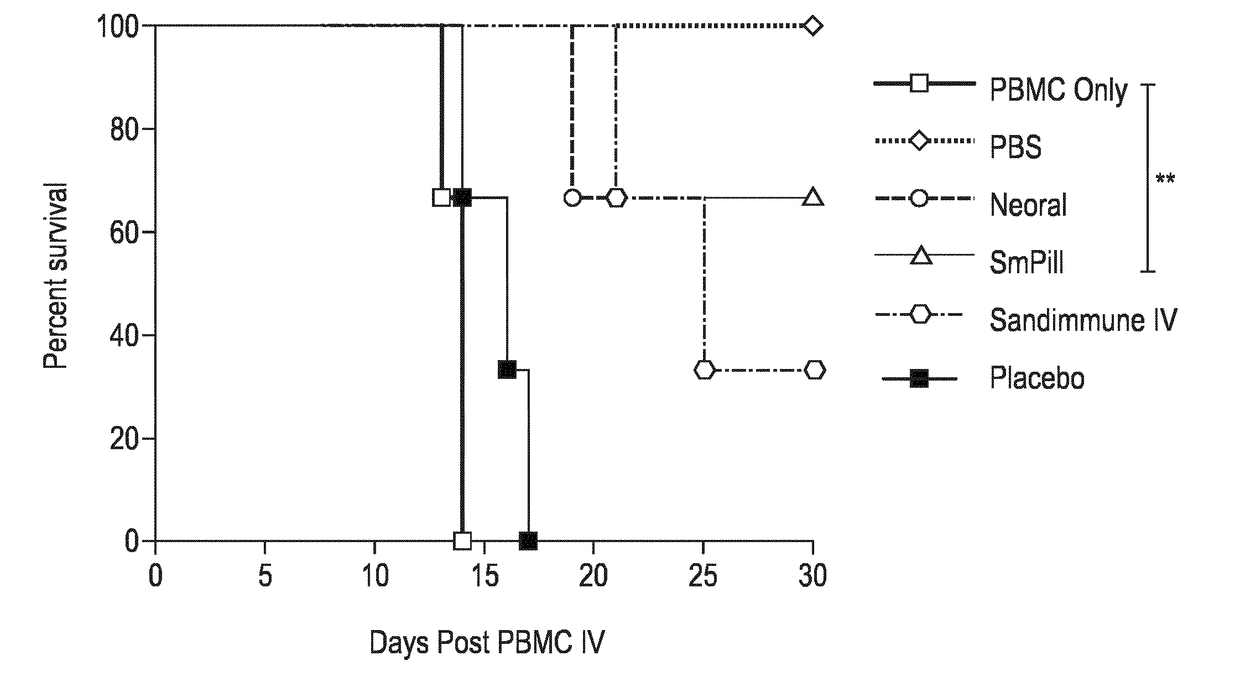Compositions
a technology of compositions and tconv cells, applied in the field of compositions, can solve the problems of limited ability of tconv cells deficient in nfat-1 and nfat-2 to induce gvhd, liable to be accompanied by gi barrier damage and local release of inflammatory cytokines, and achieve the effects of reducing or preventing one or more undesirable effects, reducing the risk of crs, and enhancing immunotherapy efficacy
- Summary
- Abstract
- Description
- Claims
- Application Information
AI Technical Summary
Benefits of technology
Problems solved by technology
Method used
Image
Examples
example 1
on of a Liquid Composition of the Invention
[0677]An aqueous phase was prepared by mixing sodium dodecyl sulphate (SDS) and D-sorbitol with purified water under constant stirring. Gelatin was then added to this solution and gentle heat was applied to approximately 60-70° C. to achieve complete melting of gelatin. The composition of the aqueous phase is shown in Table 1 below.
TABLE 1Componentw / w %water79.6SDS1.3Sorbitol2.0Gelatin17.1
[0678]An oil phase was prepared by mixing together 2-(2-ethoxyethoxy)ethanol (Transcutol HP), glyceryl monooleate / dioleate (Capmul GMO-50) and capric / caprylic triglyceride (Miglyol 810) with stirring at room temperature to form a solution. Ciclosporin A was added and mixed until a clear solution was obtained. The composition of the oil phase is shown below in Table 2.
TABLE 2Componentw / w %Cyclosporin A24.5Miglyol 810 N12.5Transcutol HP37.0Capmul GMO-5026
[0679]The oil phase was mixed with the heated aqueous phase in a ratio of approximately 1:5 (oil phase: a...
example 2
on of a Minibead
[0680]A minibead as described herein may be a composition of the invention. Alternatively the minibead may be a core. The minibead was generally prepared by forming a minibead according to the following procedure
[0681]The composition or core in the form of seamless minibeads were prepared using Spherex process as follows.
[0682]An aqueous phase and oil phase mixture was prepared following the procedure described in Example 1.
[0683]The mixture was then fed (via temperature controlled tubing) through a vibrating nozzle, with a single nozzle outlet with a diameter of 3 mm. Seamless minibeads were formed as the solution flowed through the vibrating nozzle into a cooling chamber of constantly flowing medium chain triglyceride (Miglyol 810) cooling oil at a temperature of 10° C.
[0684]The minibeads were removed from the cooling oil and placed in a centrifuge to remove the excess oil. Following centrifugation, a first drying step was initiated with a set refrigerator temperat...
example 3
on of a Minibead with an Overcoat of Ethylcellulose
[0686]A minibead coated with Opadry, the first coating (also referred to as a subcoat), was produced following the procedure in Example 3. The minibead produced by the procedure of Example 2 was then coated with an overcoat (also referred to as a second coating herein) of Surelease® (an ethylcellulose dispersion).
[0687]The Surelease® overcoat was applied by the following procedure. Surelease® was slowly added to a stainless steel vessel and mixed to provide the required coating suspension of Surelease® for the overcoat. The resulting coating suspension was then applied onto the surface of the minibeads by loading the minibeads into a fluid bed coater (Wurster column) and coating with the suspension. The processing parameters, such as inlet air temperature and inlet air volume, were adjusted to keep the minibead temperature between 40° C. and 42° C. until the required coating weight gain was reached. The over-coated minibeads were th...
PUM
| Property | Measurement | Unit |
|---|---|---|
| thickness | aaaaa | aaaaa |
| aspect ratio | aaaaa | aaaaa |
| aspect ratio | aaaaa | aaaaa |
Abstract
Description
Claims
Application Information
 Login to View More
Login to View More - R&D
- Intellectual Property
- Life Sciences
- Materials
- Tech Scout
- Unparalleled Data Quality
- Higher Quality Content
- 60% Fewer Hallucinations
Browse by: Latest US Patents, China's latest patents, Technical Efficacy Thesaurus, Application Domain, Technology Topic, Popular Technical Reports.
© 2025 PatSnap. All rights reserved.Legal|Privacy policy|Modern Slavery Act Transparency Statement|Sitemap|About US| Contact US: help@patsnap.com



